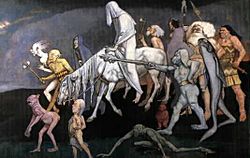Fomorians facts for kids
The Fomorians (Old Irish: Fomóire, Modern Irish: Fomhóraigh or Fomhóire) are a supernatural race in Irish mythology. They are often portrayed as hostile and monstrous beings who come from under the sea or the earth. Later, they were portrayed as giants and sea raiders. They are enemies of Ireland's first settlers and opponents of the Tuatha Dé Danann, the other supernatural race in Irish mythology. However, their relationship with the Tuath Dé is complex; some of their members intermarry and have children. The Fomorians have thus been likened to the jötnar of Norse mythology.
The Fomorians seem to have been gods who represent the harmful or destructive powers of nature; personifications of chaos, darkness, death, blight and drought. The Tuath Dé, in contrast, seem to represent the gods of growth and civilization.
Contents
Name
In Old and Middle Irish, the race is usually called the Fomóire or Fomóiri (plural), and an individual member is called a Fomóir (singular). In Middle Irish, they are also called the Fomóraiġ (plural) and a Fomórach (singular). This is spelt Fomhóraigh/Fomhóire (plural) and Fomhórach (singular) in Modern Irish. They appear as the Muiridi in the Irish version of the Historia Brittonum of Nennius. In English, they are called the Fomorians, Fomori or Fomors.
The etymology of the name is debated. The first part is now generally agreed to be the Old Irish fo, meaning under, below, lower, beneath, nether, etc. The meaning of the second part is unclear. One suggestion is that it comes from the Old Irish mur (sea), and that the name thus means something like "the undersea ones". This was the interpretation offered by some medieval Irish writers. Another suggestion is that it comes from mór (great/big) and means something like "the great under(world) ones", "the under(world) giants" or "the nether giants". A third suggestion, which has more support among scholars, is that it comes from a hypothetical Old Irish term for a demon or phantom, found in the name of The Morrígan and cognate with the archaic English word "mare" (which survives in "nightmare"). The name would thus mean something like "underworld demons/phantoms" or "nether demons/phantoms". Building on this, Marie-Louise Sjoestedt interprets the name as meaning "inferior" or "latent demons", saying the Fomorians are "like the powers of chaos, ever latent and hostile to cosmic order". John T. Koch suggests a relationship with Tartessian omuŕik.
Characteristics
Originally the Fomorians seem to have been regarded as malevolent spirits dwelling underwater and in the nether regions of the earth. Later they were portrayed as sea raiders. This was influenced by the Viking raids on Ireland that were taking place around that time.
They are often portrayed as monstrous. Sometimes they are said to have the body of a man and the head of a goat, according to an 11th-century text in Lebor na hUidre (the Book of the Dun Cow), or to have had one eye, one arm and one leg. However, those Fomorians who have relationships with the Tuath Dé, such as Elatha and his son Bres, were portrayed as darkly beautiful.
Geoffrey Keating in his 17th-century History of Ireland claimed that the Fomorians had been a seafaring people descended from Noah's son, Ham.
List of Fomorians
- Indech, King of the Fomorians
- Balor
- Bres
- Cethlenn
- Cichol Gricenchos
- Conand
- Elatha
- Ethniu
- Tethra
- Manannán under his byname the Gilla Decair
- Tuiri Tortbuillech
- Goll
- Irgoll
- Loscenn-lomm
- Octriallach, son of Indech
- Omna and Bagna
- Regan
See also
 In Spanish: Fomoré para niños
In Spanish: Fomoré para niños


